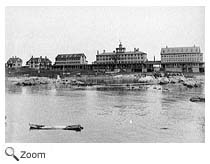Early Exploration  One of the first European visitors to the Isles of Shoals was Captain John Smith. Smith is most famous for his adventures in Jamestown, Virginia when he was saved from a death sentence by
Pocahontas, the daughter of
Chief Powhatan. One of the first European visitors to the Isles of Shoals was Captain John Smith. Smith is most famous for his adventures in Jamestown, Virginia when he was saved from a death sentence by
Pocahontas, the daughter of
Chief Powhatan.
In 1614, with the backing of London merchants, Smith left on a voyage to explore New England in search raw materials that could be sold. During his expedition, he mapped the coast of New England from
Penobscot Bay in Maine to Cape Cod in Massachusetts. During his voyage, he explored the Isles of Shoals. Smith named the Isles of Shoals "Smyths Iles." He returned from his voyage to New England with fish and furs, which proved that there was money to be made in the New World! Smith later wrote about the Isles of Shoals:
"Of all foure parts of the world that I have seene not inhabited, could I have but the meanes to transport a Colonie, I would rather live here than any where." |
Barren Islands
A fishing and trading outpost was established on Londoner's (currently Lunging) Island between 1615 and 1620.
The first recorded landing on the Isles of Shoals was by
Christopher Levett in 1623. He wrote about the Isles:
"Upon these islands I neither could see one good timber tree, or so much good ground as to make a garden." |
|
|
|
Something Fishy
The name Isles of Shoals probably originated from the large schools or "shoals" of fish that the early settlers found in the waters around the islands.
By the mid 1600s, some 600 people were living on the Isles of Shoals. Most of them lived on Hog (Appledore) and Smuttynose Island. They made their living fishing. The people who lived on the islands were very independent! In fact, when Massachusetts tried to tax the people living on Hog Island, which was in Maine, many families took apart their houses, loaded them on boats, and rowed over to Star Island in New Hampshire, where they formed the town of Gosport!
Revolutionary War
In 1778, New Hampshire ordered the people living in Gosport to the mainland. There was fear that during the Revolutionary War the independent islanders might aid the British. After the war, some residents returned to the islands, but the population never returned to its pre-war numbers. In 1870 the people remaining in Gosport were bought out by hotel interests and moved off the island.
Grand Hotels
 In the 19th and early 20th century, grand hotels were built on Appledore, Smuttynose, and Star Island. Railroads allowed vacationers to escape the summer heat in Boston and other large cities and relax on the seacoast. Today, the Oceanic Hotel on Star Island is still standing and is used as a conference center. In the 19th and early 20th century, grand hotels were built on Appledore, Smuttynose, and Star Island. Railroads allowed vacationers to escape the summer heat in Boston and other large cities and relax on the seacoast. Today, the Oceanic Hotel on Star Island is still standing and is used as a conference center. |